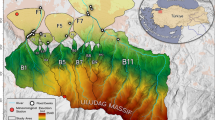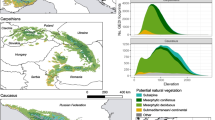Abstract
Land cover change can lead to slope instability by accelerating erosive processes associated with agriculture, forestry, and infrastructure. The Rio Chiquito-Barranca del Muerto subbasin has experienced an increase in land cover change due to government programs and the establishment of agricultural and urban areas. The aim of this study was to provide a model to map the susceptibility to gravitational processes along sites where anthropogenic land cover change has occurred. The method was based on the stratification of the subbasin according to landforms and cartographic variables. These variables were used in a multi-criteria assessment to assign weights according to their contribution to the onset of new gravitational processes. Those weights were used to create a susceptibility map based on a weighted linear sum. The accuracy of the resulting map was validated in an error matrix with a random stratified design based on susceptibility classes per landform. The results produced a map of areas with susceptibility to gravitational processes due to land cover change; this susceptibility is very high in the undifferentiated pyroclastic slope and limestone mountain, where it derives not only from anthropogenic effects on natural vegetation cover, but also from steep slopes, weathered materials, low apparent density, high erosivity, and previous gravitational processes. The results support other studies that concluded that loss of vegetation is a triggering factor in the formation of gravitational processes, but also show that excessive reforestation can increase gravitational processes.
Similar content being viewed by others
References
Aceves-Quesada F, Legorreta-Paulín P, Lugo-Hubp J, et al. (2016) Geographical information systems and geomorphological cartography applied to landslide inventory and susceptibility mapping in the El Estado river basin, Pico de Orizaba, Mexico. Geographical Research, Bulletin of the Institute of Geography. 91: 43–55. (In Spanish).
Alcántara I, Echavarría A, Gutiérrez C, et al. (2008) Instability of slopes. Series Fascicles. CENAPRED. (In Spanish).
Arnoldus HM (1980) An approximation of the rainfall factor in the Universal Soil Loss Equation. In: Assessments of Erosion, de Boodts M, Gabriels D (eds.), John Wiley and Sons Ltd, Chichester. pp 127–132. (In Spanish)
Capra L, Lugo-Hubp J, Davila N (2003) Phenomena of mass removal in the town of Zapotitlán de Méndez, Puebla: relationship between lithology and type of movement. Mexican Journal of Geological Sciences 20(2): 95–106. (In Spanish).
Carrasco-Núñez G, Vallance J, Rose W (1993) A voluminous avalanche induced lahar from Citlaltépetl volcano, México: Implications for hazard assessment. Journal of Volcanology and Geothermal Research 59: 35–46.
Card D (1982) Using known map category marginal frequencies to improve estimates of thematic map accuracy. Photogrammetric Engineering and remote sensing 48(3): 431–439.
CEC (1992) Corine soil erosion risk and important land resources inthe southern regions of the European Community. Commission of the European Community. Luxemburg.
CFE (2006) Project for integral control of torrents in the Río Blanco basin, Veracruz, Mexico. 4th World Water Forum. Mexico. Federal Electricity Commission. (In Spanish)
Chen CY, Huang WL (2013) Land use change and landslide characteristics analysis for community-based disaster mitigation. Environmental Monitoring and Assessment 185(5): 4125–4139. https://doi.org/10.1007/s10661-012-2855-y
CLICOM (2014) National climatological database. (http://clicommex.cicese.mx/, accessed on 2017-11-05). (In Spanish)
CONABIO (1998) Land use and vegetation of INEGI grouped by CONABIO. Scale 1: 1,000,000. Modified from: National Institute of Statistics and Geography. Land use and vegetation, 1996. Scale 1: 1,000,000. First edition. National Commission for the Knowledge and Use of Biodiversity. (In Spanish)
Cuanalo O, Melgarjo G (2002) Laderas Instability Sierra Norte and Northeast of the State of Puebla. Science and Culture.
Cuanalo-Campos OA, Oliva-Gonzalez AO, Gallardo-Amaya R (2011) Instability of slopes. Influence of human activity. Elements 84(18): 29. (In Spanish)De la
Cruz-Reyna S, Carrasco-Núñez G (2002) Probabilistic hazard analysis of Citlaltépetl(Pico de Orizaba)Volcano, Eastern Mexican Volcanic Belt. Journal of Volcanology and Geothermal Research 113: 307–318.
El Universal (2003) Explosion in Veracruz; 5 dead(2003, June 6). El Universal, States. (In Spanish)
Ellis E, Martínez M (2010) Vegetation and Land Use. Natural Patrimony. pp 205–226. (In Spanish)
ESRI (2016) Basemaps included in arcgis software. (http://www.esri.com/data/basemaps, accessed on 2017-11-05)
García-Palomo A, Carlos-Valerio V, López-Miguel C, et al. (2006) Landslide inventory map of Guadalupe Range, north of the Mexico Basin. Bulletin of the Mexican Geological Society. Special issue of Urban Geology 58(2): 195–204
Guzzetti F, Mondini AC, Cardinali M, et al. (2012) Landslide inventory maps: new tools for an old problem. Earth-Science Reviews 112: 42–66.
Hervá J, Bobrowsky P (2009) Mapping: Inventories, Susceptibility, Hazard and Risk. In: Sassa K, Canuti P (eds.), Landslides-Disaster Risk Reduction. Springer, Berlin. ISBN 978-3-540-69966-8. pp 321–349.
INEGI (2006) Cartographic set Series II.Scale 1: 250 000. National Institute of Statistics and Geography. Second edition. (In Spanish)
INEGI (2008) Digital orthophoto E14B56. Scale 1: 40 000. National Institute of Statistic and Geography. (In Spanish)
INEGI (2010) Population and housing census 2010. National Institute of Statistics and Geography. (http://www.censo2010.org.mx/, accessed on 2017-11-05). (In Spanish)
Kayastha P, Dhital MR, De Smedt F (2013) Application of the analytical hierarchy process(AHP)for landslides susceptibility mapping: A case study from the Tinau watershed, west Nepal. Computers and Geosciences 52: 398–408. https://doi.org/10.1016/j.cageo.2012.11.003
Kipkosgei-Kilimo R (2014) Land cover changes and landslide occurrence: A case of Tirap Division in Elgeyo Marakwet county, Kenya. University of Nairobi. Department of Urban and Regional Planning.
Legorreta-Paulín G, Bursik M (2008) Logisnet: A tool for multimethod, multiple soil layers slope stability analysis: Computers and Geosciences, computers & geosciences. 35(5): 1007–1016. https://doi.org/10.1016/j.cageo.2008.04.003
Legorreta-Paulín G, Lugo-Hubp J (2014) Hazard zonation due to gravitational processes on the southwestern flank of the Pico de Orizaba volcano, Mexico. Geographic Research. 84: 20–31. (In Spanish)
Legorreta-Paulín G, Bursik M, Solene P, et al. (2014) Multitemporal inventory, susceptibility analysis and volume estimation of landslides on the SWflank of the Pico de Orizaba volcano, Puebla-Veracruz. Bulletin of the Mexican Geological Society 66: 343–354. (In Spanish)
Lobo D, Lozano Z, Delgado F (2005) Water erosion risk assessment and impact on productivity of a Venezuelan soil. Catena 64:297.
Macías JL (2005) Geology and eruptive history of some of the great active volcanoes of Mexico. Bulletin of the Mexican Geological Society. Commemorative volume of the centenary 57: 3379–424. (In Spanish)
Marcano A, Cartaya S, Pacheco H, et al. (2015) Estimation of weighted weights of variables for the generation of susceptibility maps through the Multicriteria Spatial Evaluation(EEM). Terra New Stage 31(50): 55–80.
Mas J, Pérez A, Ghilardi A, et al. (2014) A suite of tools for assessing thematic map accuracy. Geography Journal(http://www.hindawi.com/journals/geography/2014/372349/, accessed on 2017-11-05). https://doi.org/10.1155/2014/372349
Mendoza M, Domínguez L (2006) Estimation of the threat and risk of landslides on hillsides. Basic guide for the elaboration of state and municipal atlases of dangers and risks. SEGOBCENAPRED. Mexico. (In Spanish)
Morrissey MM, Wieczorek GF, Morgan BA (2001) A comparative analysis of hazard models for predicting debris flows in Madison County, Virginia: United States Geological Survey Open-File Report 01-0067.
Olivas-Gallegos UE, Valdez-Lazalde JR, Aldrete A, et al. (2007) Areas with aptitude to establish maguey cenizo plantations: definition by multicriteria analysis and GIS. Fitotec, Mexico. 30(4): 411–419. (In Spanish)
Palacio JL, Bocco G, Velázquez A, et al. (2000) The current condition of forest resources in Mexico: results of the national forest inventory 2000. Geographical Investigations 43. Institute of Geography, UNAM. Mexico. 183–203. (In Spanish)
Palacios D, Parrilla G, Zamorano J (1999) Paraglacial and postglacial debris flows on a Little Ice Age terminal moraine: Jamapa Glacier, Pico de Orizaba(México). Geomorphology 28: 95–118.
Peñalva-Rosales LP (2000) Proposals of fuzzy logic in decision making. Politics and Culture Metropolitan Autonomous University Xochimilco Unit Federal District, Mexico. 13: 97–112. (In Spanish)
Pérez-Gutiérrez R (2007) Analysis of vulnerability due to mass landslides, case: Tlacuitlapa, Guerrero. Bulletin of the Mexican Geological Society 59(2): 171–181. (In Spanish)
Pineda N, Bosque J, Gómez M, et al. (2009) Analysis of land use change in the State of Mexico using geographic information systems and multivariate regression techniques. Geographical Research 69. Institute of Geography, UNAM. Mexico. pp 33–52. (In Spanish)
Pizarro R, Ausensi P, Aravena D, et al. (2003) Evaluation of hydrological methods for the completion of missing rainfall data in rainfall stations of the VII Region of Maule, Chile. Technological Center of environmental hydrology. University of Talca, Chile. (In Spanish)
Pourghasemi HR, Pradhan B, Gokceoglu C (2012) Application of fuzzy logic and analytical hierarchy process(AHP)to landslide susceptibility mapping at Haraz watershed, Iran. Natural Hazards 63: 965–996. https://doi.org/10.1007/s11069-012-0217-2
Reichenbach P, Busca C, Mondini AC, et al. (2014) The Influence of Land Use Change on Landslide Susceptibility Zonation: The Briga Catchment Test Site(Messina, Italy). Environ Manage 56(6): 1372–1384. https://doi.org/10.1007/s00267-014-0357-0
Roa J (2007) Estimation of areas susceptible to landslides through satellite data and images: the Mocotíes river basin, Mérida state, Venezuela. Venezuelan Geographic Magazine. 48(2): 183–219. (In Spanish)
Rodríguez S, Mora I, Murrieta J (2006) Low concentration flows associated with rains of extraordinary intensity on the southern flank of the Pico de Orizaba volcano(Citlaltépetl), Mexico. Bulletin of the Mexican Geological Society. Special issue of Urban Geology 2: 223–236. (In Spanish)
Saaty TL (2008) Decision making with the analytic hierarchy process. International Journal Services Sciences UK 1(1): 83–98.
SGM (2000) Veracruz E14-3. Geological-Mining Chart. Scale 1: 250 000. Mexican Geological Service. First edition. (In Spanish)
Sheridan MF, Carrasco-Núñez G, Hubbard BE, et al. (2001) Hazard Map of the Citlaltépetl Volcano (Pico de Orizaba), scale 1: 250,000: National Autonomous University of Mexico, Autonomous University of Puebla, Government of the State of Veracruz, 1 map. (In Spanish)
SMN (2013) Weather normals by station. (http://smn.cna.gob.mx, accessed on 2017-11-05). (In Spanish)
Tazik E, Jahantab Z, Bakhtiari M, et al. (2014) Landslide susceptibility mapping by combining the three methods Fuzzy Logic, Frequency Ratio and Analytical Hierarchy Process in Dozain basin. The International Archives of the Photogrammetry, Remote Sensing and Spatial Information Sciences. The 1st ISPRS International Conference on Geospatial Information Research, 15–17 November 2014, Tehran, Iran. https://doi.org/10.5194/isprsarchives-XL-2-W3-267-2014
Vigueras-Velázquez ME, Carbajal-Hernández JJ, Sánchez-Fernández LP, et al. (2016) Computational model for the evaluation of water quality in white fish farming. Educational tracks. National Technological Institute of Mexico/Technological Institute of Celaya, Mexico. (In Spanish)
Villegas R, Muñoz C, Muñoz O, et al. (2011) Rate of land use change in the Pico de Orizaba National Park, Veracruz, Mexico. Period 2003-2011. CONANP e INECOL. (In Spanish)
Washington State Department of Natural Resources(DNR), Forest Practices Division (2006) Landslide Hazard Zonation (LHZ) Mapping Protocol, version 2.0.
Werner G (1996) The vegetation destroyed in the Mexican highlands. Elements 2: 9–25. (In Spanish)
Williamson M (2009) Multitemporal analysis to detect changes in land use in three municipalities affected by Hurricane Juana. Wani 58: 52–57. (In Spanish)
Acknowledgements
This project was made possible thanks to PAPIIT IN102115 project, program Basic Science SEP-CONACYT (167495), CONACYT scholarship program (328294) and Postgraduate Program in Geography, UNAM. We are also grateful to the Geospatial Analysis Laboratory at the Institute of Geography, UNAM, for SPOT satellite imagery. To Dr. Ann Grant, María Elena Sánchez-Salazar, Felipe Campos-Cerda and Luis Barba-Escoto for assistance with the translation of this work. Finally, to the reviewers of the journal for their wise comments that contributed to the significant improvement of this work.
Author information
Authors and Affiliations
Corresponding author
Additional information
Electronic supplementary material: Supplementary material (Appendix 1) is available in the online version of this article at https://doi.org/10.1007/s11629-016-4268-9.
Electronic supplementary material
Rights and permissions
About this article
Cite this article
Alanís-Anaya, R.M., Legorreta-Paulín, G., Mas, J.F. et al. Susceptibility to gravitational processes due to land cover change in the Río Chiquito-Barranca del Muerto subbasin (Pico De Orizaba Volcano, México). J. Mt. Sci. 14, 2511–2526 (2017). https://doi.org/10.1007/s11629-016-4268-9
Received:
Revised:
Accepted:
Published:
Issue Date:
DOI: https://doi.org/10.1007/s11629-016-4268-9




